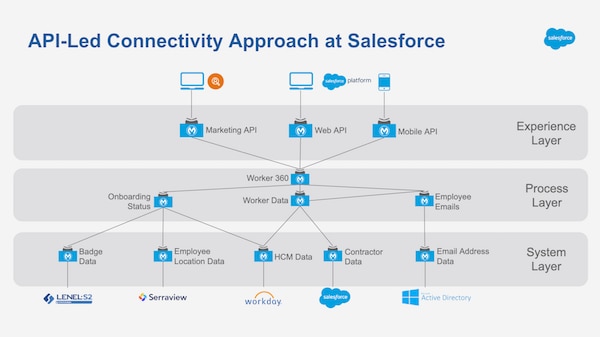We often talk about the power of integrating data and leveraging APIs (application programming interface) to build connected customer experiences. But as we talk to CIOs and business leaders, they equally stress the importance of building connected employee experiences. Eighty-four percent of IT leaders say improving employee technology is a critical initiative for their company. However, only 50% of IT leaders are increasing their investment in employee-facing technology.
Why is building connected employee experiences so hard?
Why is there such a large gap between the percentage of leaders who say they should invest in employee experience and the ones who are actually investing? It’s because building employee applications is challenging. Employees expect apps to be responsive, intelligent, and personalized. And those applications need to be connected and powered by data from systems across your business. Your teams need to seamlessly integrate these systems with the app and with each other to build that connected experience. Since the average business process now spans more than 35 systems, there’s a lot to integrate. The sooner businesses rethink their strategy and start building connections with reuse in mind, the less time they will spend writing and rewriting custom code, allowing teams to focus on delivering innovative employee experiences.
How we unlocked our siloed employee data
We were facing the same challenges as our customers. Over the years, as we hired more employees and acquired new companies, our employee information was spread across multiple back-end systems. Payroll, benefits, employee info, and more were all siloed, meaning our Employee Success teams had to switch between systems and manually update to consolidate information. The silos between these systems prevented us from building connected employee applications. This meant that one their first day, our employees were not getting the connected experience we had hoped they would. Thirty-six percent of our new hires at Salesforce weren’t getting all of the business equipment they needed on their first day of work, causing them to give our Day 1 experience a rating of three out of five.
We needed to rethink the employee experience and transform how we onboarded our employees. This meant reimagining our integration strategy and connecting our back-end systems so that we could build an application to simplify employee onboarding. Enter MuleSoft and an API-led approach to connectivity.
Through an API-led approach, we were able to surface data with System APIs, unlocking multiple systems and instances like HCM data from Workday and badge data from Lenel. By combining System APIs and adding business logic, the team developed Process APIs, ultimately creating a reusable “Worker 360” API.

With the data surfaced, we were able to meet our employee’s expectations and use experience APIs to build connected applications that improved various employee activities. We started with addressing our onboarding challenge.
Improving employee experience with integration and low-code
We built the New Hire Wizard on the Customer 360 Platform using Lightning. The app helps streamline new employee provisioning and onboarding, so managers can focus on welcoming their new hire and building a relationship instead of logistical tasks. Since all previously siloed, relevant data now powers the New Hire Wizard, it has an impressive usage rate of 96%. Ultimately, improving the onboarding and provisioning experience with the app aided in improving our Day 1 rating to a 4.6 out of 5.
More importantly, because the app is built with APIs, developers can discover and reuse the employee data through MuleSoft to save time on future projects instead of rewriting custom code. By reusing the Worker 360 API and other APIs, we cut the delivery time of new Employee Success projects by seven months. Now, our developers can focus on innovation and building other apps, such as a new training app, ensuring we onboard all employees successfully.
Learn more about how Salesforce surfaced data with MuleSoft to build a transformative employee app on the Salesforce Platform.




![While Salesforce builds enterprise-grade security into every part of our platform, customers play a vital role in protecting their data. [Image: Adobe]](https://www.salesforce.com/blog/wp-content/uploads/sites/2/2025/03/Protect-Your-Salesforce-Environment-with-Best-Practices-Strong-Access-Controls-and-Proactive-Security-Measures.png?w=128&h=96&crop=1&quality=75)























